
The percentage of American adults with a college degree has continued to increase in recent years, growing from less than 10% in much of the 1960s, up to 33.1% in 2019. Americans with college degrees not only tend to earn higher incomes than those without, but they also typically have longer and healthier lives.
Though bachelor’s degree attainment rates are increasing, there is still a large variation in the share of college-educated adults in parts of the country. In a handful of states, over 40% of all adults 25 and older have graduated from college. In others, fewer than one quarter hold at least a bachelor’s degree.
To determine the most and least educated states, 24/7 Wall St. reviewed data on educational attainment from the U.S. Census Bureau’s 2019 American Community Survey. States were ranked based on the percentage of adults 25 years and over with at least a bachelor’s degree. Supplemental data on median household income and median earnings by educational attainment also came from the 2019 ACS. Data on annual average unemployment and monthly unemployment came from the Bureau of Labor Statistics.
States with the highest educational attainment rates tend to be in Northeast. Meanwhile, the states that are home to the smallest share of college educated adults are disproportionately concentrated in the South.
While bachelor’s degree holders tend to be financially better off than those without, this is not always the case. Certain majors do not promise the same income potential as others, and some graduates may make well below half of what the typical college graduate makes in a given year. These are the college majors that will pay off the least.
Click here to see the most and least educated states

50. West Virginia
> Adults with at least a bachelor’s degree: 21.1% (2019); 21.3% (2018)
> Median earnings for bachelor’s degree holders:/strong> $45,304 (4th lowest)
> Median earnings for all workers: $35,440
> Unemployment: 4.9% (2019); 5.2% (2018)
Only 21.1% of West Virginia residents aged 25 and up have a bachelor’s degree or higher, the smallest share of any state in the country. The state’s low bachelor’s degree attainment rate may partially be explained by the relatively small financial incentive. The typical worker with a bachelor’s degree in West Virginia earns $45,304 a year, only about $10,000 more than the median earnings for workers of all education levels. Meanwhile, nationwide, the typical worker with a bachelor’s degree earns $56,344, about $15,000 more than the median earnings for all workers.
[in-text-ad]

49. Mississippi
> Adults with at least a bachelor’s degree: 22.3% (2019); 23.2% (2018)
> Median earnings for bachelor’s degree holders:/strong> $44,148 (2nd lowest)
> Median earnings for all workers: $32,574
> Unemployment: 5.4% (2019); 4.8% (2018)
Mississippi is one of just three states in which fewer than a quarter of adults 25 and older have at least a bachelor’s degree. It is also just one of two states in which most college graduates earn less than $45,000 per year. Fewer well-paying jobs for those with a bachelor’s degree may partially explain the relatively small share of adults with a four-year college education in Mississippi.

48. Arkansas
> Adults with at least a bachelor’s degree: 23.3% (2019); 23.3% (2018)
> Median earnings for bachelor’s degree holders:/strong> $46,964 (6th lowest)
> Median earnings for all workers: $35,215
> Unemployment: 3.5% (2019); 3.6% (2018)
Only 23.3% of adults in Arkansas have a bachelor’s degree or higher — 10 percentage points below the 33.1% national bachelor’s degree attainment rate. Incomes tend to rise with educational attainment, and states with lower educational attainment rates also tend to have lower than average incomes and higher poverty.
In Arkansas, the typical household earns $48,952 a year, well below the national median household income of $65,712. Additionally, 16.2% of Arkansas residents live below the poverty line, compared to 12.3% of Americans nationwide.

47. Louisiana
> Adults with at least a bachelor’s degree: 25.0% (2019); 24.3% (2018)
> Median earnings for bachelor’s degree holders:/strong> $50,699 (17th lowest)
> Median earnings for all workers: $37,599
> Unemployment: 4.8% (2019); 4.9% (2018)
In Louisiana, only about one in every four adults have a four-year college degree or higher, compared to about one in every three adults nationwide. Though the share is small, it represents a larger increase from the previous year than in most of the country. In 2018, only 24.3% of adults in Louisiana had a bachelor’s degree.
Incomes tend to rise with educational attainment, and from 2018 to 2019, the median household income also climbed in Louisiana. The typical household in the state earned $51,073 in 2019, a greater than average 4.9% increase from 2018.
[in-text-ad-2]

46. Kentucky
> Adults with at least a bachelor’s degree: 25.1% (2019); 24.8% (2018)
> Median earnings for bachelor’s degree holders:/strong> $50,711 (18th lowest)
> Median earnings for all workers: $37,674
> Unemployment: 4.3% (2019); 4.3% (2018)
The bachelor’s degree attainment rate in Kentucky stands at 25.1%, the fifth lowest among states and well below the 33.1% national share. Americans who have a four-year college education are far less likely to face serious financial hardship than those with lower educational attainment. In Kentucky, 16.3% of the population lives below the poverty line, the fourth highest poverty rate of any state, and well above the 12.3% national poverty rate.

45. Nevada
> Adults with at least a bachelor’s degree: 25.7% (2019); 24.9% (2018)
> Median earnings for bachelor’s degree holders:/strong> $50,293 (13th lowest)
> Median earnings for all workers: $39,505
> Unemployment: 3.9% (2019); 4.4% (2018)
Though Nevada’s 25.7% bachelor’s degree attainment rate is well below the national rate of 33.1%, it is on the rise, increasing from 24.9% in 2018. The 0.8 percentage point increase is one of the larger increases among states.
Adults with a college education tend to have better job security. Still, despite this increase in educational attainment, Nevada’s economy remains largely focused on tourism and has been hit especially hard by COVID-19. Its April unemployment rate spiked to over 30.1% and remains the highest in the nation, at 13.2% as of August.
[in-text-ad]

44. Oklahoma
> Adults with at least a bachelor’s degree: 26.2% (2019); 25.6% (2018)
> Median earnings for bachelor’s degree holders:/strong> $47,828 (11th lowest)
> Median earnings for all workers: $38,088
> Unemployment: 3.3% (2019); 3.4% (2018)
Across the U.S., workers 25 and older with at least a bachelor’s degree earn approximately $14,500 more than all workers that age, regardless of educational attainment. Yet in Oklahoma, median earnings for bachelor’s degree holders outpace the overall median earnings by less than $10,000.
College-educated workers are less likely to struggle with poverty, and Oklahoma, which has the seventh lowest educational attainment rate, has the eighth highest poverty rate at 15.2%, well above the 12.3% nationwide poverty rate.
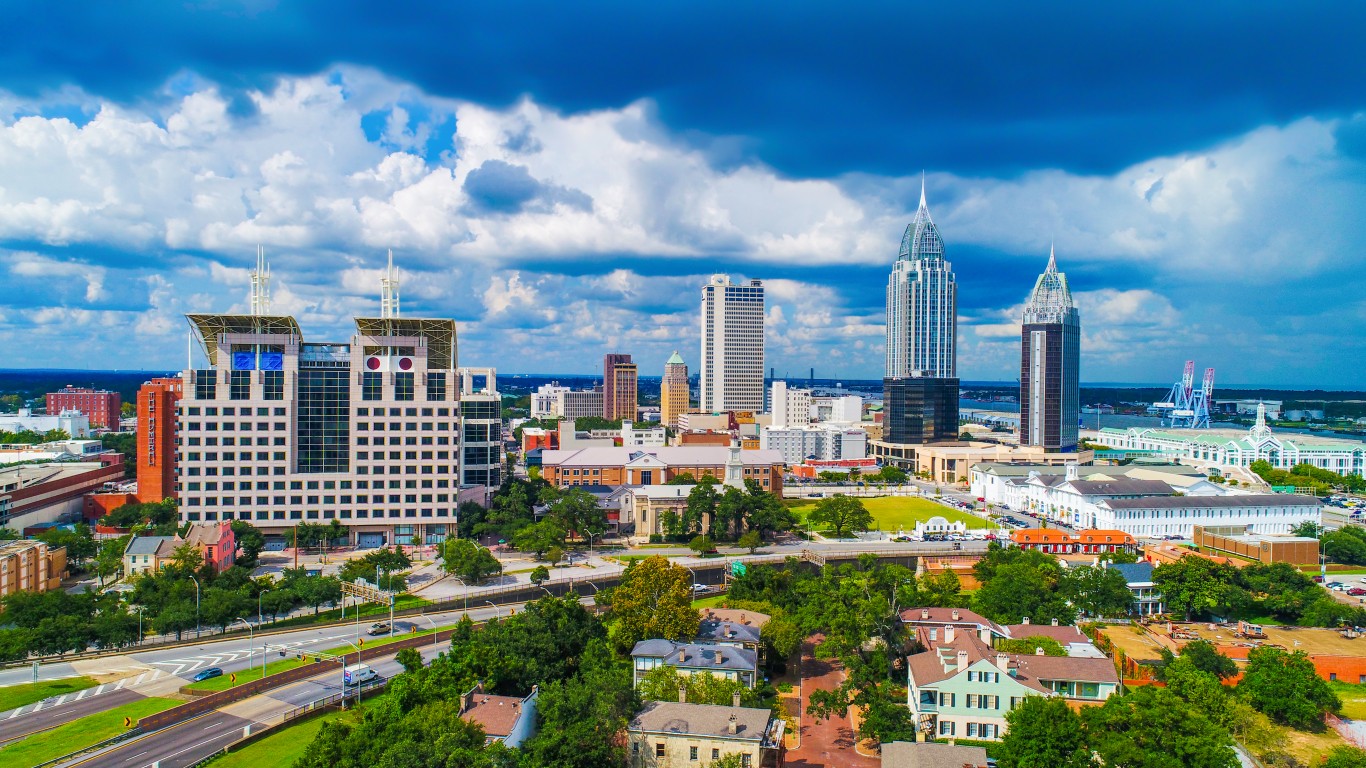
43. Alabama
> Adults with at least a bachelor’s degree: 26.3% (2019); 25.5% (2018)
> Median earnings for bachelor’s degree holders:/strong> $50,643 (16th lowest)
> Median earnings for all workers: $37,217
> Unemployment: 3.0% (2019); 3.9% (2018)
Though Alabama has one of the lower bachelor’s degree attainment rates of all states, at 26.3%, the rate is improving — up 0.8 percentage points from 2018. Meanwhile, the national bachelor’s degree attainment rate climbed by just 0.5 percentage points over the same period.
Unemployment tends to be lower among workers with a college degree. As the share of college-educated adults in the state increased, the state’s unemployment rate dropped from 3.9% in 2018 to 3.0% in 2019, the largest improvement of any state.
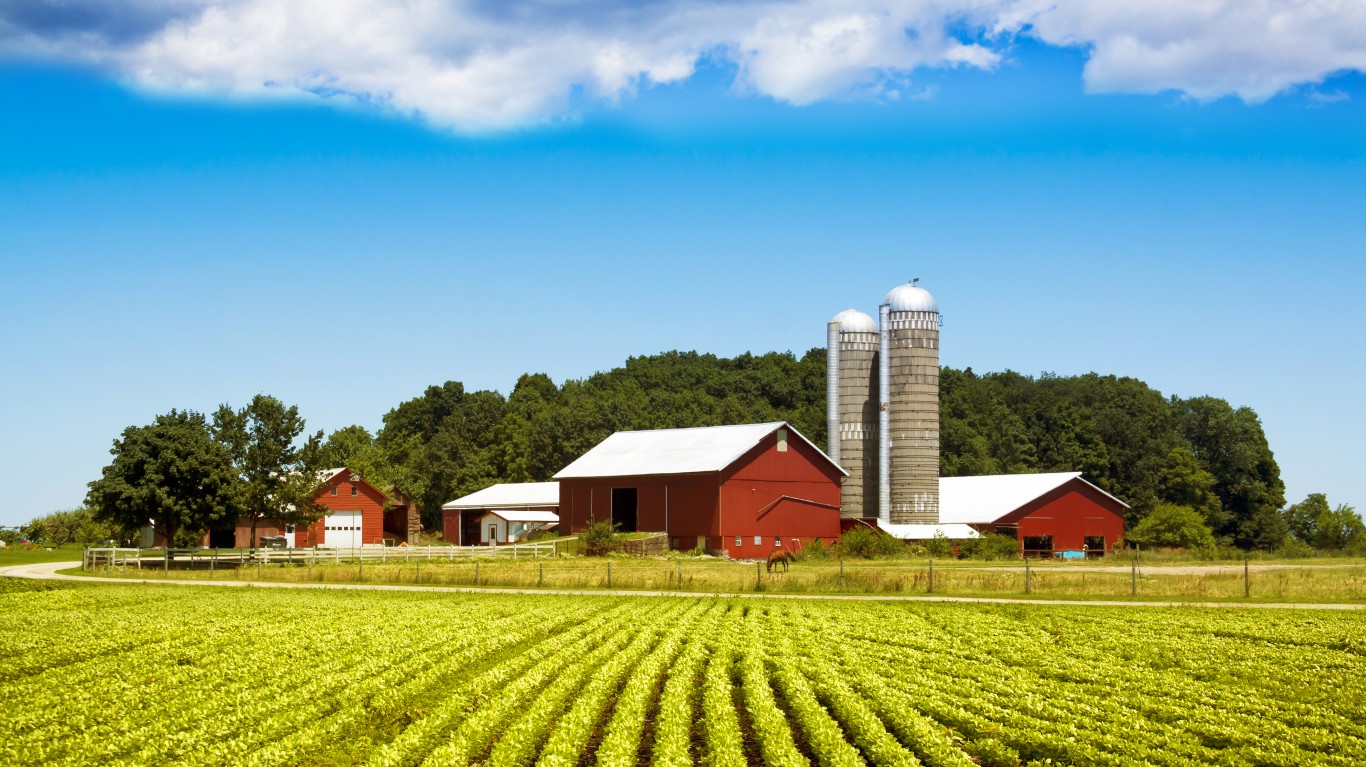
42. Indiana
> Adults with at least a bachelor’s degree: 26.9% (2019); 27.1% (2018)
> Median earnings for bachelor’s degree holders:/strong> $50,630 (14th lowest)
> Median earnings for all workers: $39,833
> Unemployment: 3.3% (2019); 3.5% (2018)
In Indiana, only 26.9% of residents aged 25 and up have a bachelor’s degree or higher, well below the 33.1% share of adults nationwide. The state’s low bachelor’s degree attainment rate may partially be explained by the relatively small financial incentive. The typical worker with a bachelor’s degree in Indiana earns $50,630 a year, only about $11,000 more than the median earnings for workers of all education levels. Meanwhile, nationwide, the typical worker with a bachelor’s degree earns $56,344, about $15,000 more than the median earnings for all workers.
[in-text-ad-2]
41. New Mexico
> Adults with at least a bachelor’s degree: 27.7% (2019); 27.7% (2018)
> Median earnings for bachelor’s degree holders:/strong> $45,109 (3rd lowest)
> Median earnings for all workers: $35,284
> Unemployment: 4.9% (2019); 4.9% (2018)
In New Mexico, 27.7% of adults have a bachelor’s degree or higher, the second smallest share of any western state and the 10th smallest share nationwide. Nationwide, the typical worker with a bachelor’s degree earns over $56,000 a year. In New Mexico, however, the median earnings for those with a four-year college education is just $45,109. Fewer well-paying job opportunities for the college educated in the state likely reduces the incentive for individuals to invest the time and money in higher education.

39. Idaho (tied)
> Adults with at least a bachelor’s degree: 28.7% (2019); 27.7% (2018)
> Median earnings for bachelor’s degree holders:/strong> $46,364 (5th lowest)
> Median earnings for all workers: $36,445
> Unemployment: 2.9% (2019); 2.9% (2018)
Incomes tend to rise with educational attainment — and in Idaho, just 28.7% of adults have a bachelor’s degree or higher, one of the smallest shares of any state. Despite the low educational attainment, serious financial hardship is less common than average in Idaho. Only 11.2% of Idaho residents live below the poverty line, compared to 12.3% of Americans nationwide.
[in-text-ad]
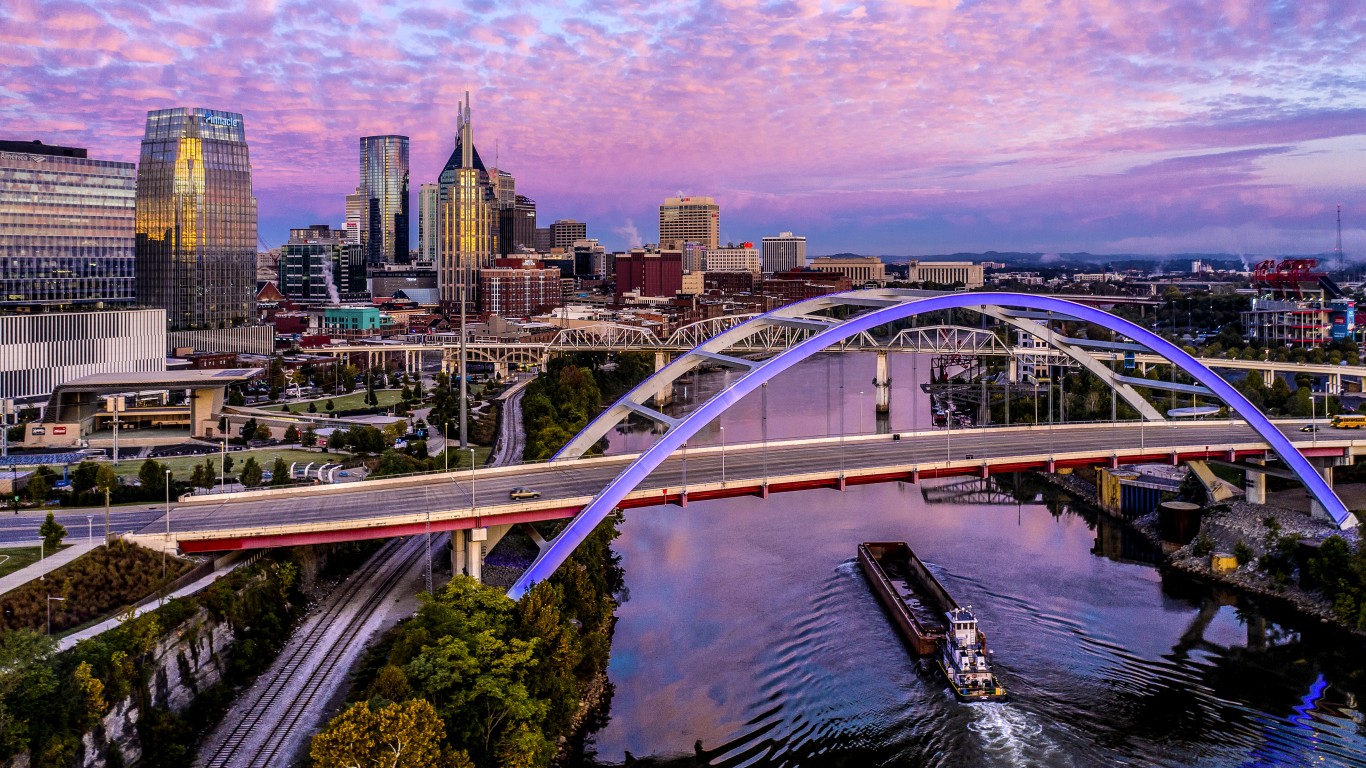
39. Tennessee (tied)
> Adults with at least a bachelor’s degree: 28.7% (2019); 27.5% (2018)
> Median earnings for bachelor’s degree holders:/strong> $50,633 (15th lowest)
> Median earnings for all workers: $37,610
> Unemployment: 3.4% (2019); 3.5% (2018)
Between 2018 and 2019, the share of adults with a four-year college education climbed more in Tennessee than in all but a handful of other states. The state’s bachelor’s degree attainment rate now stands at 28.7% — up 1.2 percentage points from the previous year.
Adults with a bachelor’s degree are less likely to be unemployed and more likely to earn higher incomes than those with lower educational attainment. Though there are multiple additional factors at play, in keeping with that pattern, as Tennessee’s bachelor’s degree attainment rate climbed, the state’s average unemployment rate dipped by a fraction of a percent and the median household income climbed 5.3% — from $53,274 in 2018 to $56,071 in 2019.
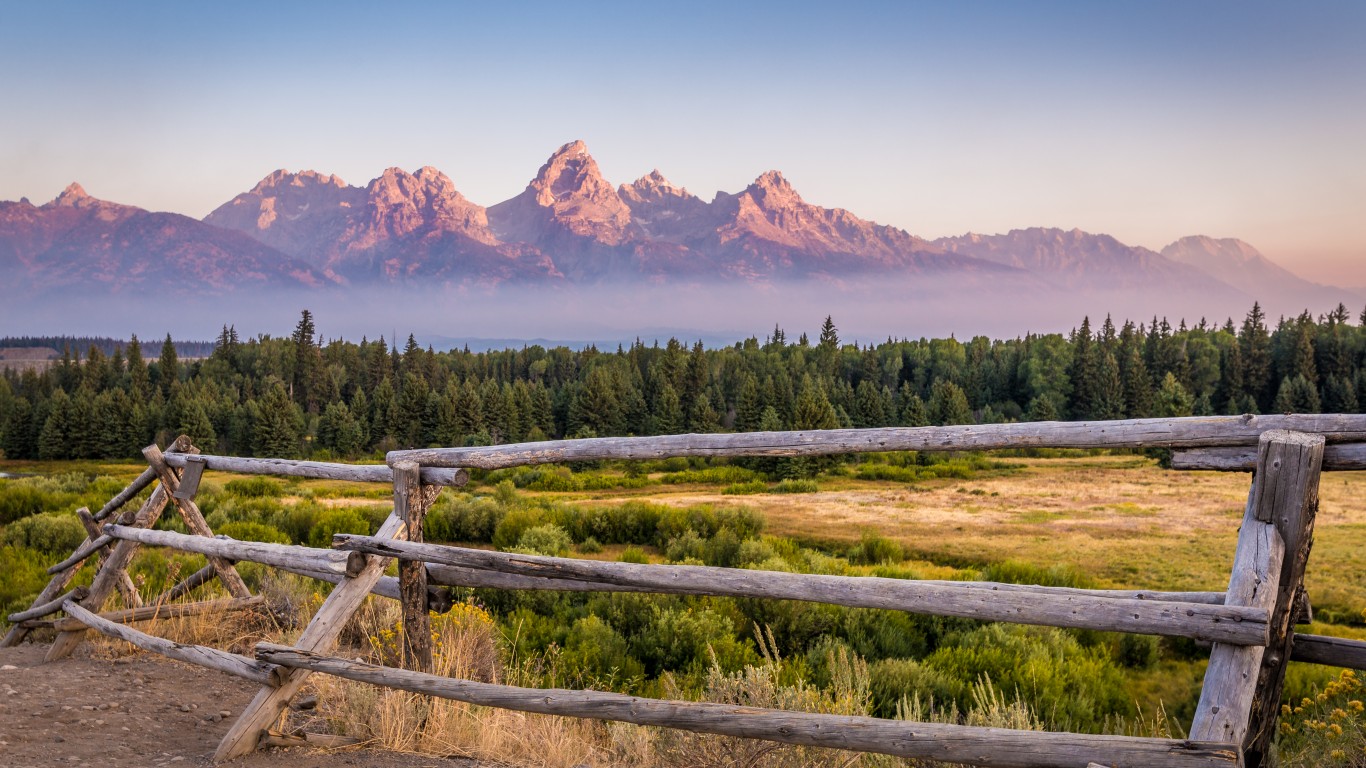
38. Wyoming
> Adults with at least a bachelor’s degree: 29.1% (2019); 26.9% (2018)
> Median earnings for bachelor’s degree holders:/strong> $47,962 (12th lowest)
> Median earnings for all workers: $40,800
> Unemployment: 3.6% (2019); 3.9% (2018)
The financial incentive for earning a bachelor’s degree in Wyoming is relatively small. The typical worker in the state with a four-year college education earns $47,962 a year, only about $7,000 more than the median annual earnings for workers of all education levels in the state. Meanwhile, nationwide, the typical worker with a bachelor’s degree earns $56,344, about $15,000 more than all the median earnings for all workers. Fewer well-paying jobs that require a college degree may partially explain Wyoming’s low bachelor’s degree attainment rate. Just 29.1% of the state’s 25 and older population have a bachelor’s degree, compared to 33.1% of adults in the same age group nationwide.

36. Iowa (tied)
> Adults with at least a bachelor’s degree: 29.3% (2019); 29.0% (2018)
> Median earnings for bachelor’s degree holders:/strong> $51,751 (25th lowest)
> Median earnings for all workers: $41,268
> Unemployment: 2.7% (2019); 2.6% (2018)
Adults in Iowa are less likely than most American adults to have a four-year college education. Just 29.3% of state residents 25 and older have a bachelor’s degree, compared to 33.1% of American adults. However, Iowa performs better than the country as a whole in other measures of educational attainment. An estimated 92.6% of the state’s 25 and older residents have a high school diploma or equivalent, compared with just 88.6% of adults nationwide.
[in-text-ad-2]

36. Ohio (tied)
> Adults with at least a bachelor’s degree: 29.3% (2019); 29.0% (2018)
> Median earnings for bachelor’s degree holders:/strong> $53,680 (18th highest)
> Median earnings for all workers: $40,586
> Unemployment: 4.1% (2019); 4.5% (2018)
Ohio’s bachelor’s degree attainment rate of 29.3% is the 15th lowest among states and the third lowest in the Midwest. Incomes tend to rise with educational attainment, and just as Ohio adults residents are less likely than American adults to be college educated, they are also less likely to be high earners. The median annual household income in the state is $58,642, about $7,000 less than the national median of $65,712. Additionally, only 5.4% of households in Ohio earn $200,000 or more per year, compared to 8.5% of households nationwide.
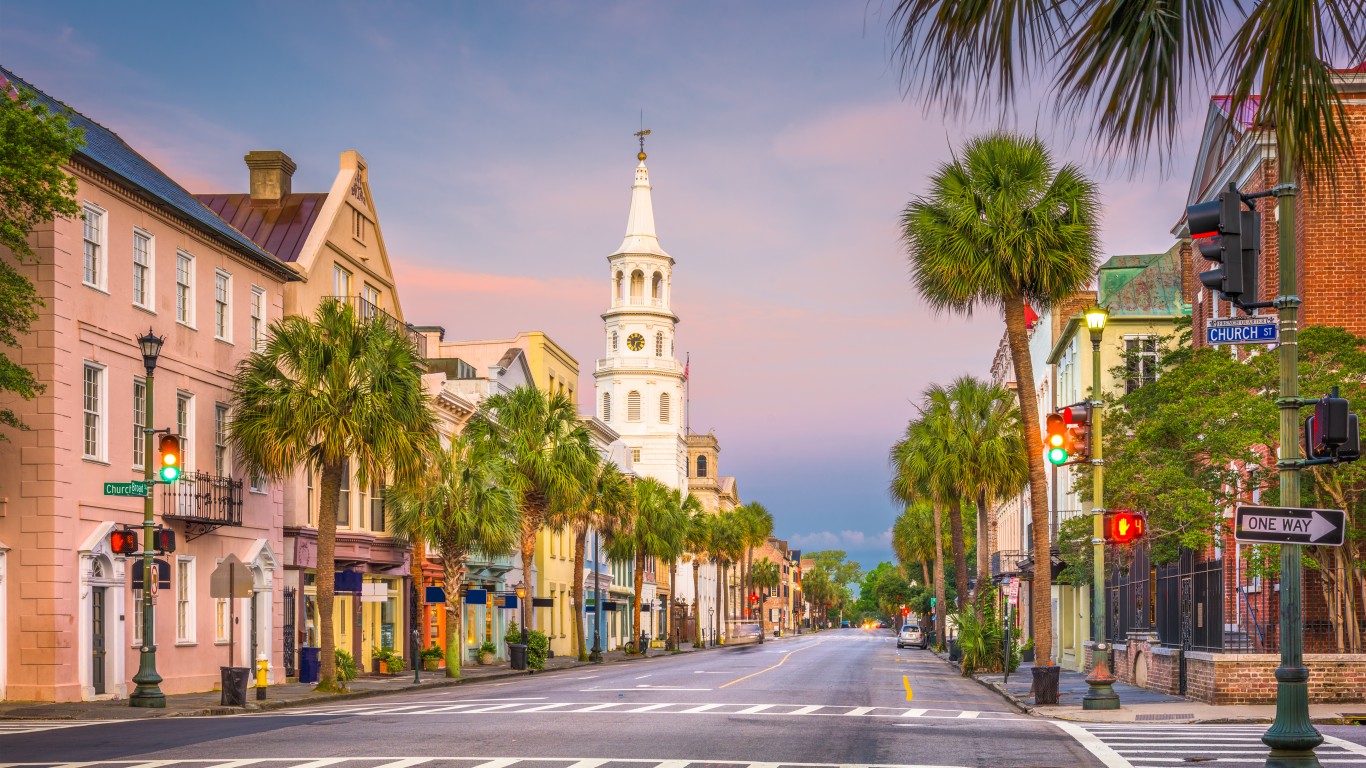
35. South Carolina
> Adults with at least a bachelor’s degree: 29.6% (2019); 28.3% (2018)
> Median earnings for bachelor’s degree holders:/strong> $50,734 (19th lowest)
> Median earnings for all workers: $37,727
> Unemployment: 2.8% (2019); 3.5% (2018)
South Carolina is one of just eight states in which the percentage of adults with at least a bachelor’s degree grew by more than 1 percentage point in 2019, from 28.3% in 2018 to 29.6%. Yet the state’s bachelor’s degree attainment rate is still well below the U.S. rate of 33.1%.
Adults with a college education tend to have better job security. Still, despite a relatively low educational attainment rate, South Carolina workers were less likely to be unemployed in 2019 than those in all but a handful of other states. The state’s 2.8% unemployment rate was lower than all but six other states, and well below the 3.7% U.S. rate.
[in-text-ad]

34. South Dakota
> Adults with at least a bachelor’s degree: 29.7% (2019); 29.2% (2018)
> Median earnings for bachelor’s degree holders:/strong> $47,630 (9th lowest)
> Median earnings for all workers: $38,646
> Unemployment: 3.3% (2019); 3.1% (2018)
In South Dakota, 29.7% of adults 25 and older have at least a bachelor’s degree. Though degree holders do tend to earn more than those with lower levels of education in this state, the difference is relatively small. The state’s median earnings for those with no more than a high school diploma is $31,306, just slightly below the U.S. median earnings for high school graduates of $31,956. Yet the state’s median earnings for bachelor’s degree holders of $47,630 is more than $8,000 lower than the $56,344 U.S. median for degree holders.

33. Michigan
> Adults with at least a bachelor’s degree: 30.0% (2019); 29.6% (2018)
> Median earnings for bachelor’s degree holders:/strong> $54,634 (17th highest)
> Median earnings for all workers: $40,450
> Unemployment: 4.1% (2019); 4.1% (2018)
The share of adults with a bachelor’s degree or higher in Michigan climbed slightly from 29.6% in 2018 to 30.0% in 2019.
Over the same period, the median household income in Michigan went from $57,518 to $59,584. While incomes were up overall in the state, the share of wealthy households actually declined. Only 6.2% of Michigan households earned more than $200,000 in 2019, down half a percentage point from 6.7% in 2018.

30. Missouri (tied)
> Adults with at least a bachelor’s degree: 30.2% (2019); 29.5% (2018)
> Median earnings for bachelor’s degree holders:/strong> $51,217 (22nd lowest)
> Median earnings for all workers: $40,078
> Unemployment: 3.3% (2019); 3.2% (2018)
Missouri is one of four states in which the bachelor’s degree attainment rate increased to 30% or higher in 2019. Though Missouri’s bachelor’s degree attainment rate is lower than the national rate of 33.1%, adults in the state are more likely to have finished high school than the typical American adult. In 2019, 90.7% of Missourians 25 and older had a high school diploma, compared to 88.6% of Americans in that same age group.
[in-text-ad-2]
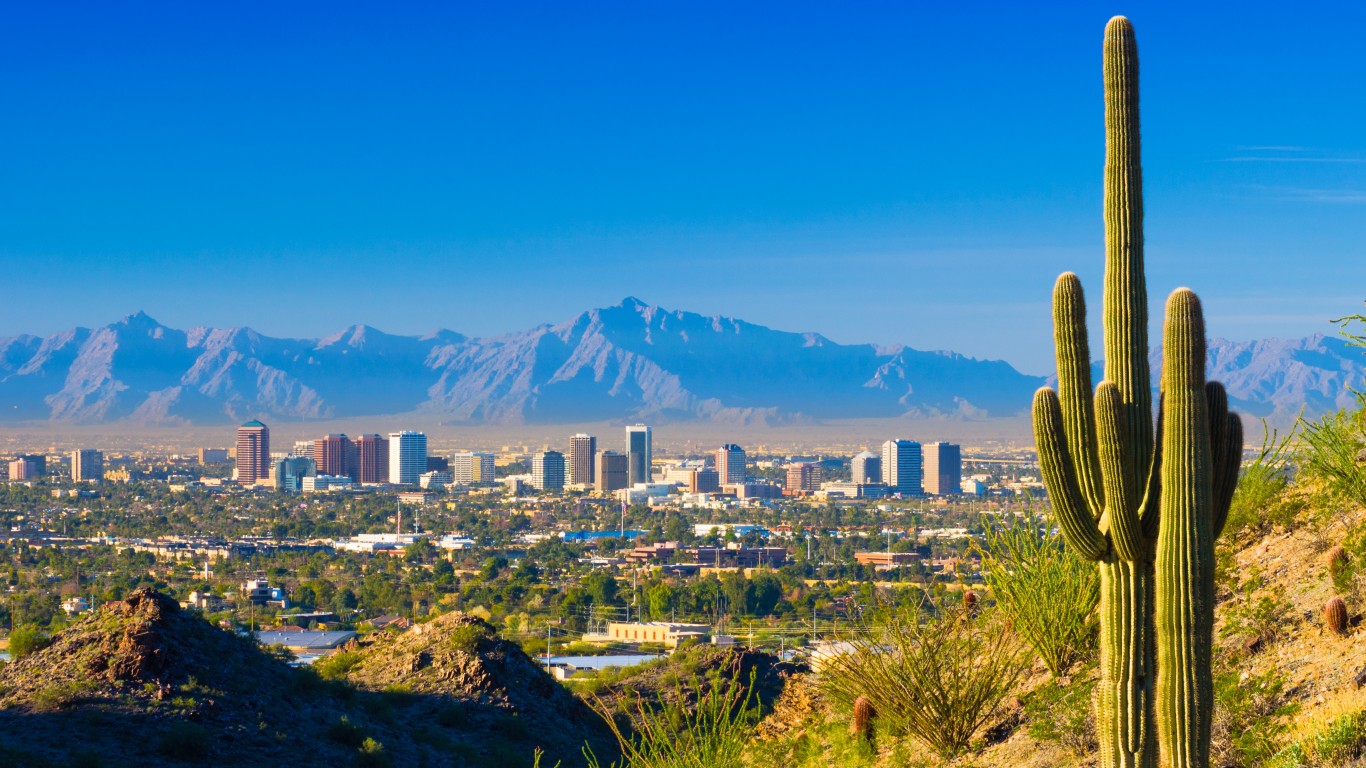
30. Arizona (tied)
> Adults with at least a bachelor’s degree: 30.2% (2019); 29.7% (2018)
> Median earnings for bachelor’s degree holders:/strong> $52,077 (24th highest)
> Median earnings for all workers: $39,956
> Unemployment: 4.7% (2019); 4.7% (2018)
In Arizona, 30.2% of adults have a bachelor’s degree or higher — a smaller share than in most states and well below the 33.1% national bachelor’s degree attainment rate. Arizona residents are also slightly less likely to have completed high school than Americans nationwide. Just 87.6% of the state’s adult residents have a high school diploma or equivalent, compared to 88.6% of adults nationwide.
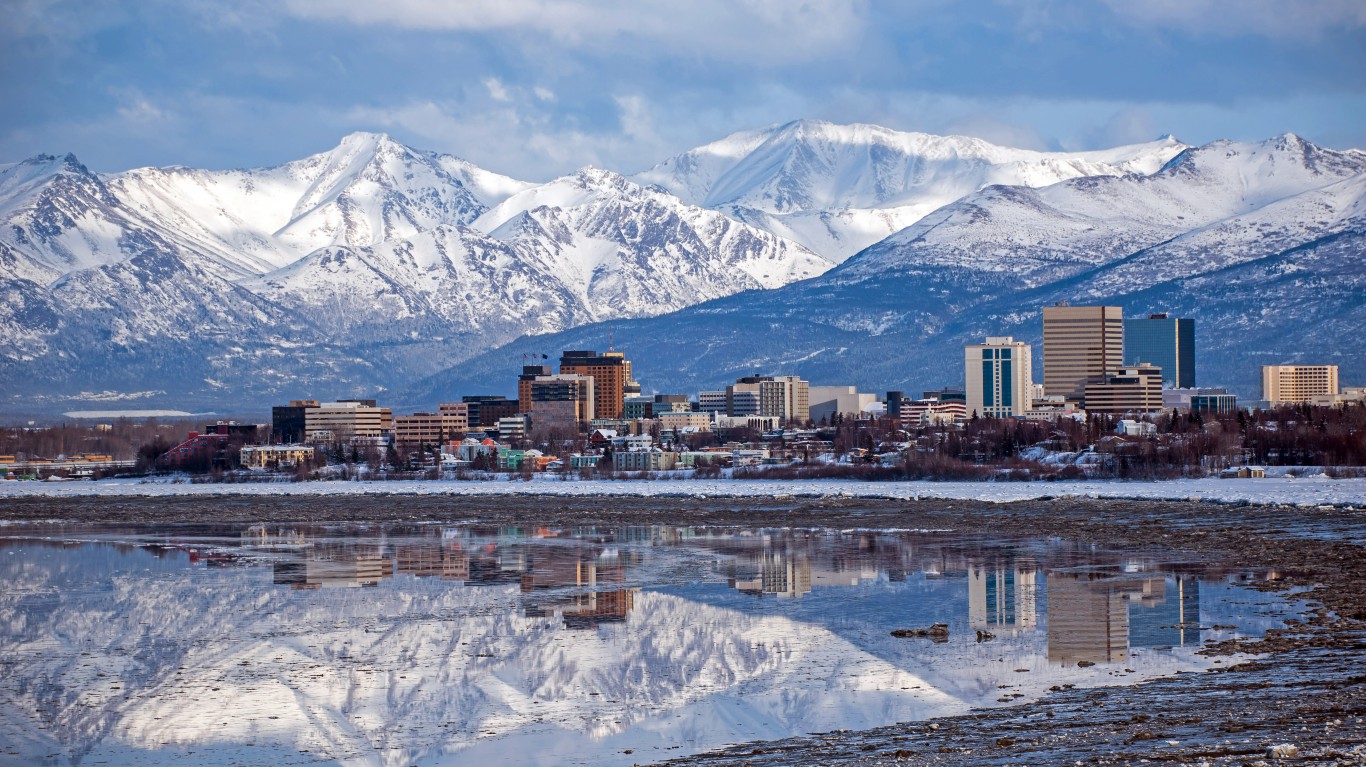
30. Alaska (tied)
> Adults with at least a bachelor’s degree: 30.2% (2019); 30.2% (2018)
> Median earnings for bachelor’s degree holders:/strong> $53,033 (20th highest)
> Median earnings for all workers: $47,809
> Unemployment: 6.1% (2019); 6.5% (2018)
Though Alaska has the third highest share of residents 25 and older with a high school diploma, at 93.6%, its bachelor’s degree attainment rate is lower than that of most states, at 30.2%. The rate remained unchanged from 2018 to 2019, even as the overall U.S. attainment rate increased by half a percentage point.
Alaska’s median earnings for all workers is one of the highest in the country at $47,809 — $6,000 more than the comparable U.S. median. Yet median earnings for workers with a bachelor’s degree or higher in the state is $53,033, more than $3,000 lower than the median earnings for working Americans with that level of educational attainment.
[in-text-ad]

29. North Dakota
> Adults with at least a bachelor’s degree: 30.4% (2019); 29.7% (2018)
> Median earnings for bachelor’s degree holders:/strong> $51,854 (25th highest)
> Median earnings for all workers: $43,865
> Unemployment: 2.4% (2019); 2.6% (2018)
The kinds of well-paying jobs that require higher educational attainment do not appear to be as common in North Dakota as they are nationwide, while well-paying jobs for workers with lower education levels appear more common. The typical worker with a bachelor’s degree in the state earns $51,854 annually, only $8,000 more than the median annual earnings for state workers of all education levels. Similarly, the typical worker with a graduate or professional degree earns just $61,288, or about $17,000 more than median earnings for all workers. Nationwide, the typical worker with a bachelor’s degree earns $56,344, and the typical worker with an advanced degree earns $75,495, or about $15,000 and $34,000 more than the median earnings for all workers, respectively.
This may partially explain North Dakota’s lower than average 30.4% bachelor’s degree attainment rate and 8.9% advanced degree attainment rate.
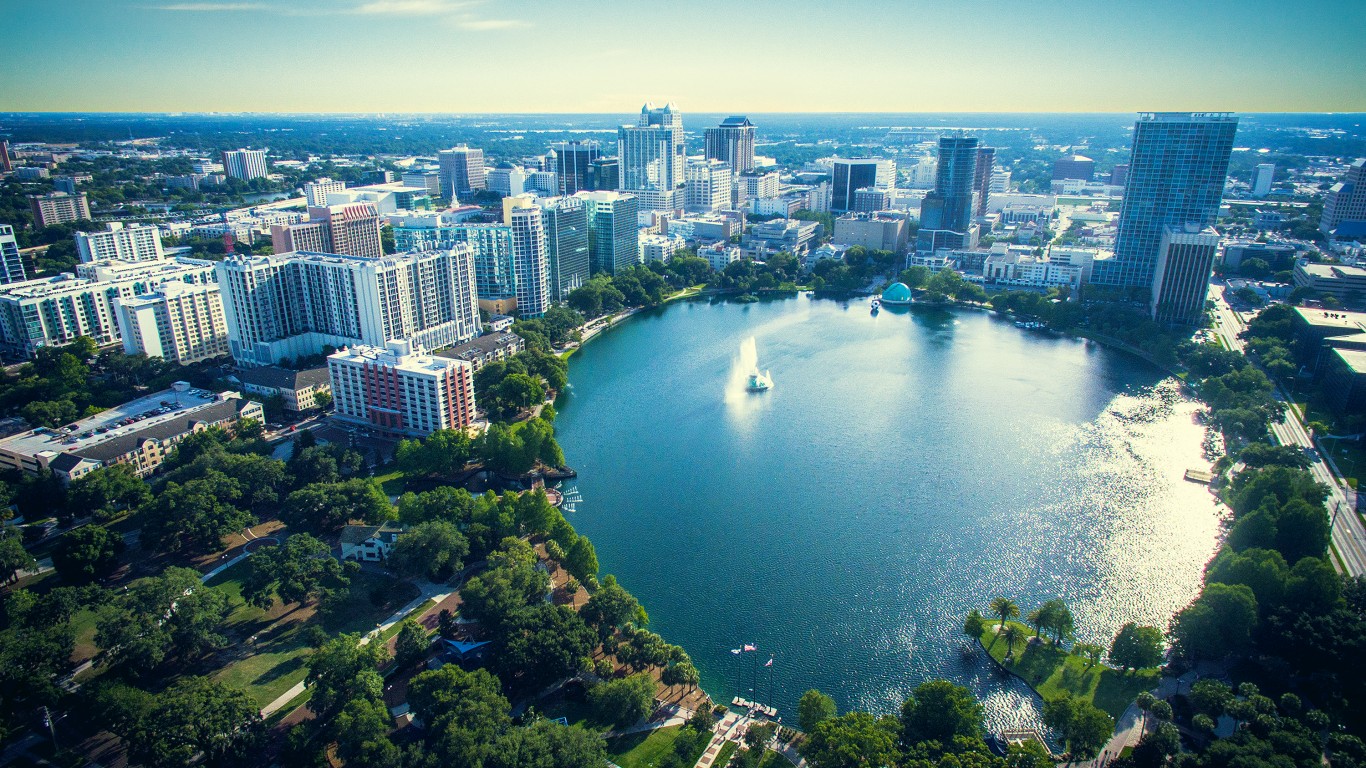
28. Florida
> Adults with at least a bachelor’s degree: 30.7% (2019); 30.4% (2018)
> Median earnings for bachelor’s degree holders:/strong> $47,810 (10th lowest)
> Median earnings for all workers: $36,021
> Unemployment: 3.1% (2019); 3.6% (2018)
In Florida, 30.7% of adults 25 and older have at least a bachelor’s degree — a smaller share than in most states and well below the 33.1% national share. However, adults in Florida are more about as likely to have a high school diploma as the typical American adult. An estimated 88.4% of the state’s 25 and older residents have completed high school, compared to 88.6% of Americans nationwide in the same age range.
Florida has the fifth lowest median earnings for all workers at just over $36,000 and the 10th lowest median earnings for bachelor’s degree holders at $47,810.
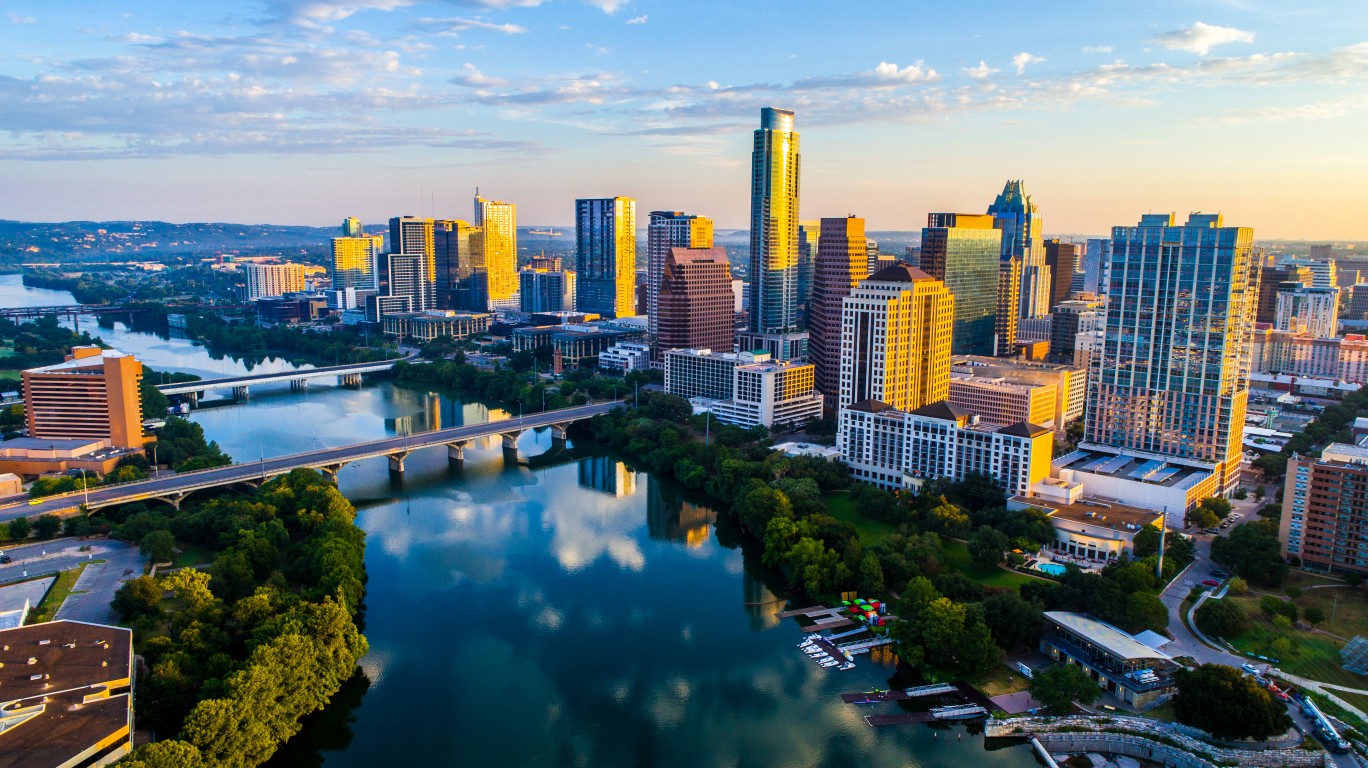
27. Texas
> Adults with at least a bachelor’s degree: 30.8% (2019); 30.3% (2018)
> Median earnings for bachelor’s degree holders:/strong> $56,853 (14th highest)
> Median earnings for all workers: $40,895
> Unemployment: 3.5% (2019); 3.8% (2018)
Just 30.8% of adults in Texas have a bachelor’s degree or higher, well below the 33.1% share of adults nationwide. The education gap is even more pronounced at the high school level. Just 84.6% of Texans 25 and older have completed high school, compared to 88.6% of Americans nationwide in the same age group.
Incomes tend to rise with educational attainment, and despite being home to smaller than average shares of college and high school-educated adults, the state’s median household income of $64,034 is only slightly lower than the national median of $65,712.
[in-text-ad-2]
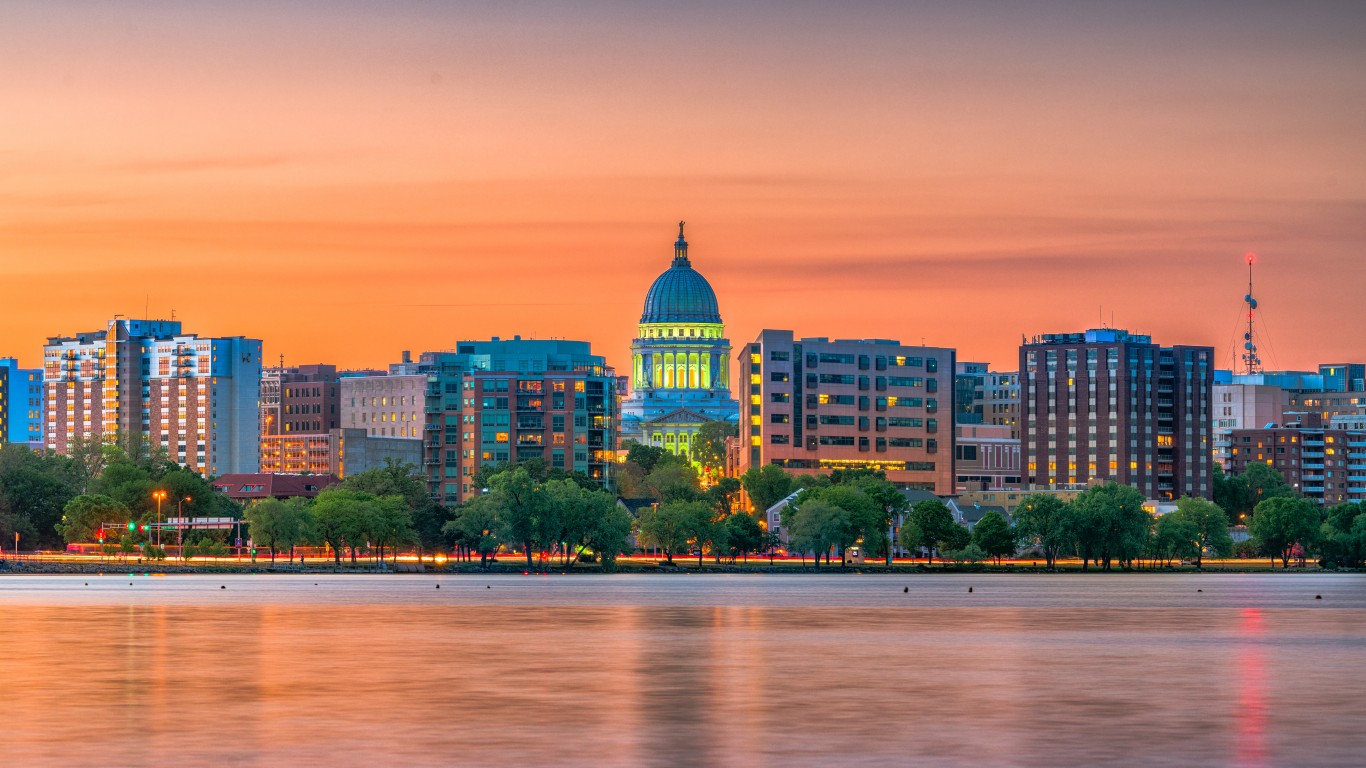
26. Wisconsin
> Adults with at least a bachelor’s degree: 31.3% (2019); 30.0% (2018)
> Median earnings for bachelor’s degree holders:/strong> $52,425 (22nd highest)
> Median earnings for all workers: $42,222
> Unemployment: 3.3% (2019); 3.0% (2018)
Wisconsin’s bachelor’s degree attainment increased from 30% in 2018 to 31.3% in 2019. Though this is one of the largest increases of any state, Wisconsin’s educational attainment is still short of the U.S. degree attainment rate of 33.1%. During the same time, the state’s high school diploma attainment rate increased by 0.7 percentage points to 92.8% — the 10th highest share of any state.

24. North Carolina (tied)
> Adults with at least a bachelor’s degree: 32.3% (2019); 31.9% (2018)
> Median earnings for bachelor’s degree holders:/strong> $50,977 (21st lowest)
> Median earnings for all workers: $38,534
> Unemployment: 3.9% (2019); 4.0% (2018)
The 32.3% bachelor’s degree attainment rate in North Carolina ranks in the middle of all states and slightly below the 33.1% share of adults nationwide with a bachelor’s degree or higher. Still, compared to other states in the South, North Carolina ranks among the best educated. Of all 15 other states in the South, Georgia, Delaware, Virginia, and Maryland are the only ones with a higher bachelor’s degree attainment rate higher than North Carolina.
[in-text-ad]

24. Pennsylvania (tied)
> Adults with at least a bachelor’s degree: 32.3% (2019); 31.8% (2018)
> Median earnings for bachelor’s degree holders:/strong> $55,326 (16th highest)
> Median earnings for all workers: $42,229
> Unemployment: 4.4% (2019); 4.2% (2018)
Though Pennsylvania’s bachelor’s degree attainment rate of 32.3% ranks near the middle of states, it is still lower than the national 33.1% rate.
Adults with a college education tend to have better job security. Still, Pennsylvania has had an unemployment rate that consistently ranks among the highest in the country. The state’s 4.4% unemployment rate in 2019 was the seventh highest among states. As the COVID-19 pandemic has stretched on, Pennsylvania’s economic recovery has lagged behind the country’s overall recovery, and its 10.3% unemployment rate in August 2020 also was among the 10 highest nationwide.

23. Georgia
> Adults with at least a bachelor’s degree: 32.5% (2019); 31.9% (2018)
> Median earnings for bachelor’s degree holders:/strong> $53,662 (19th highest)
> Median earnings for all workers: $40,312
> Unemployment: 3.4% (2019); 3.9% (2018)
In Georgia, 32.5% of adults 25 and older have at least a bachelor’s degree. Though this is a higher share than most states, it is still short of the U.S. bachelor’s degree attainment rate of 33.1%. Meanwhile, Georgia’s median earnings for bachelor’s degree holders ranks 19th highest, at $53,662. The state’s $40,312 median earning for all workers ranks 30th among all states.

20. Maine (tied)
> Adults with at least a bachelor’s degree: 33.2% (2019); 31.5% (2018)
> Median earnings for bachelor’s degree holders:/strong> $47,375 (8th lowest)
> Median earnings for all workers: $39,550
> Unemployment: 3.0% (2019); 3.2% (2018)
Northeastern states tend to have far higher than average educational attainment rates. For example, Maine has the second lowest bachelor’s degree attainment in the Northeast, behind every other state in the region except for Pennsylvania. Still, the 33.2% share of adults in Maine with a bachelor’s degree or higher is larger than in most states and slightly above the 33.1% national share.
[in-text-ad-2]
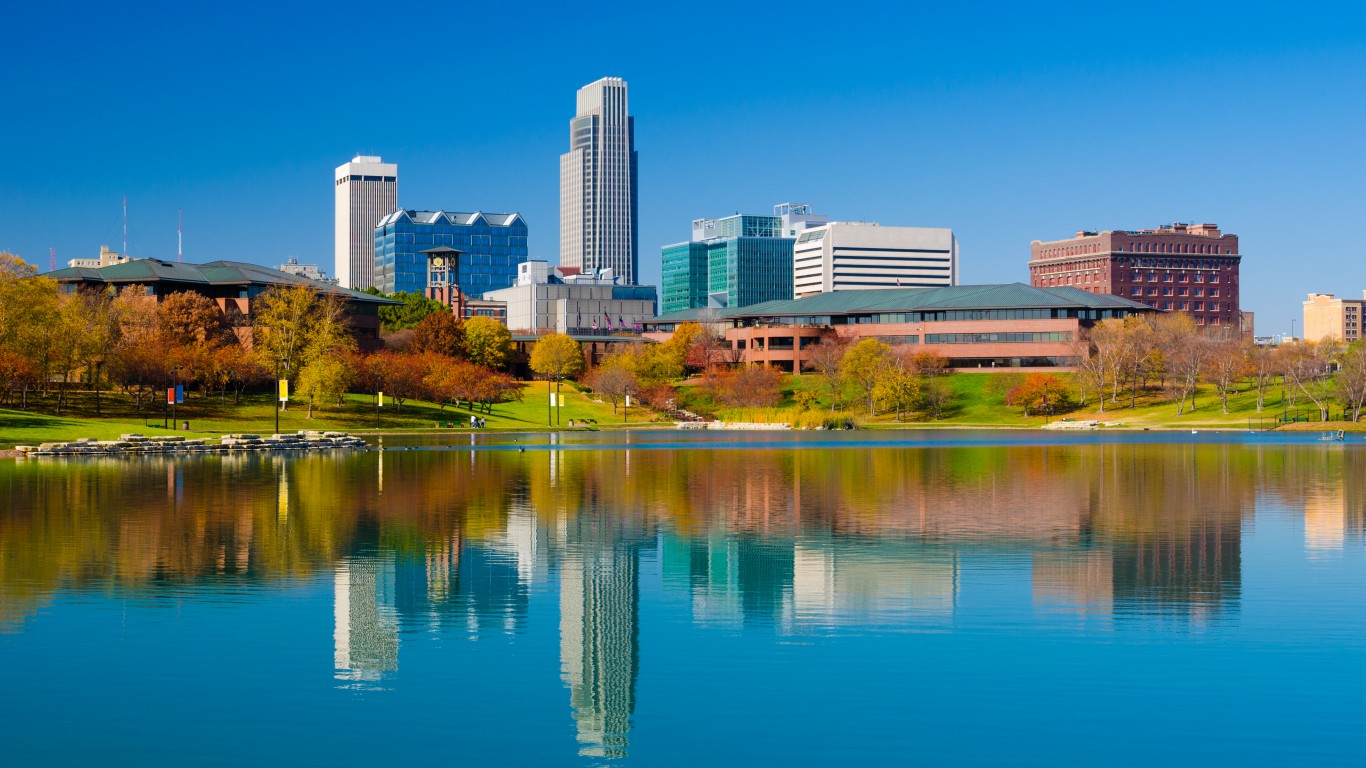
20. Nebraska (tied)
> Adults with at least a bachelor’s degree: 33.2% (2019); 32.4% (2018)
> Median earnings for bachelor’s degree holders:/strong> $50,779 (20th lowest)
> Median earnings for all workers: $41,488
> Unemployment: 3.0% (2019); 2.9% (2018)
Nearly one-third of Nebraska adults 25 and older have at least a bachelor’s degree, slightly ahead of the U.S. rate. Adults in Nebraska are also more likely than most American adults to have a high school diploma. Of all state residents aged 25 and up, 92.0% have completed high school, compared with 88.6% of all Americans in the same age group.
Though Nebraska’s median earnings for all workers is nearly in line with the nationwide median, its median earnings for bachelor’s degree holders, at $50,779, is more than $5,000 below the comparable U.S. median.
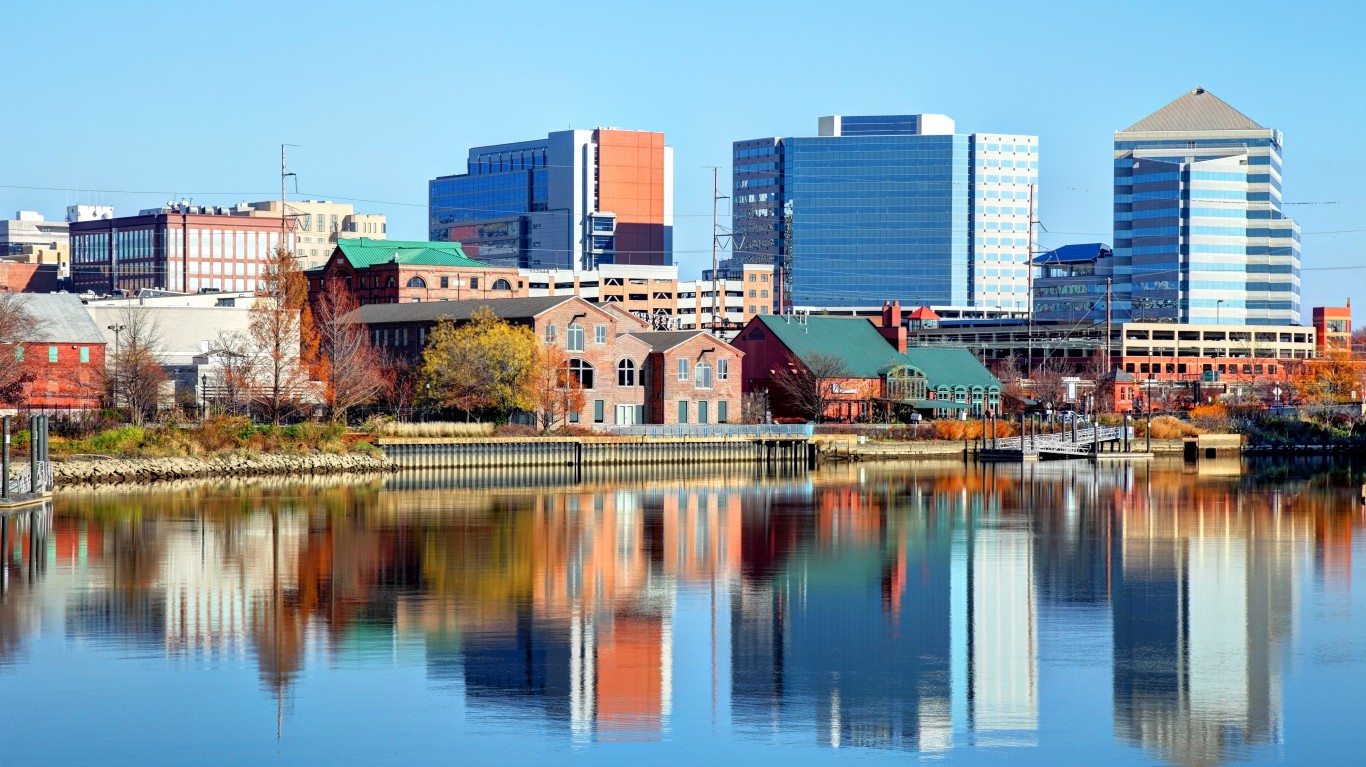
20. Delaware (tied)
> Adults with at least a bachelor’s degree: 33.2% (2019); 31.3% (2018)
> Median earnings for bachelor’s degree holders:/strong> $56,603 (15th highest)
> Median earnings for all workers: $43,164
> Unemployment: 3.8% (2019); 3.8% (2018)
The bachelor’s degree attainment rate Delaware’s increased 1.9 percentage points between 2018 and 2019, tied for the second highest increase among states, and nearly four times the national increase. With 33.2% of the state’s 25 and over residents holding at least a bachelor’s degree, Delaware ranks as the 20th most educated state, tied with Maine and Nebraska. Delaware is also home to a relatively large share of residents with an advanced degree, such as a master’s or doctorate, at 13.7%. Nationwide, 12.8% of adults are similarly well educated.
[in-text-ad]

18. Montana (tied)
> Adults with at least a bachelor’s degree: 33.6% (2019); 31.7% (2018)
> Median earnings for bachelor’s degree holders:/strong> $42,150 (the lowest)
> Median earnings for all workers: $36,953
> Unemployment: 3.5% (2019); 3.6% (2018)
Montana is one of 19 states in which more than one in every three residents age 25 and up have a bachelor’s degree. The state has a slightly higher than average bachelor’s degree attainment rate despite a lack of financial incentive. The typical worker with a bachelor’s degree in Montana earns just $42,150 a year, the lowest median income for workers with similar education levels of any state, and only about $5,000 more than the median income for workers of all education levels. For comparison, nationwide, the typical worker with a bachelor’s degree earns $56,344, about $15,000 more than the median earnings for all workers.

18. Hawaii (tied)
> Adults with at least a bachelor’s degree: 33.6% (2019); 33.5% (2018)
> Median earnings for bachelor’s degree holders:/strong> $52,183 (23rd highest)
> Median earnings for all workers: $44,557
> Unemployment: 2.7% (2019); 2.5% (2018)
Adults in Hawaii are slightly more likely than the typical American adult to have a four-year college education. An estimated 33.6% of state residents 25 and older have a bachelor’s degree compared to 33.1% of Americans nationwide in the same age group. Hawaiians are also more likely to have completed high school than the typical American. Across the state, 92.4% of adults have a high school diploma or equivalent, compared with 88.6% of all American adults.

17. Kansas
> Adults with at least a bachelor’s degree: 34.0% (2019); 33.8% (2018)
> Median earnings for bachelor’s degree holders:/strong> $51,678 (24th lowest)
> Median earnings for all workers: $41,181
> Unemployment: 3.2% (2019); 3.3% (2018)
In Kansas, 34.0% of adults have a bachelor’s degree or higher, the 17th largest share of all states and the third largest in the Midwest. The state has a higher than average bachelor’s degree attainment rate despite a relatively limited financial incentive. The typical worker with a bachelor’s degree in Kansas earns $51,678 a year, only about $10,000 more than the median earnings for workers of all education levels. Meanwhile, nationwide, the typical worker with a bachelor’s degree earns $56,344, about $15,000 more than the median earnings for all workers.
[in-text-ad-2]

16. Oregon
> Adults with at least a bachelor’s degree: 34.5% (2019); 34.0% (2018)
> Median earnings for bachelor’s degree holders:/strong> $52,498 (21st highest)
> Median earnings for all workers: $40,774
> Unemployment: 3.7% (2019); 4.1% (2018)
Across the United States, workers with a bachelor’s degree typically earn about 35% more than the median annual earnings across all education levels. In Oregon, a relatively well-educated state where a larger than average 34.5% share of adults have a bachelor’s degree or higher, incomes are also higher than average. The typical household in the state earns $67,058 — compared to the national median household income of $65,712.

14. Utah (tied)
> Adults with at least a bachelor’s degree: 34.8% (2019); 34.9% (2018)
> Median earnings for bachelor’s degree holders:/strong> $51,611 (23rd lowest)
> Median earnings for all workers: $41,679
> Unemployment: 2.6% (2019); 3.0% (2018)
Both job and financial security tend to rise with educational attainment. In Utah, 34.5% of adults have a bachelor’s degree or higher, higher than in most other states and above the 33.1% national bachelor’s degree attainment rate.
Likely due in part to the state’s larger than average college-educated population, only 3.6% of households in the state earn less than $10,000 a year, the smallest share of any state and well below the 5.8% comparable national share. Additionally, Utah’s 2.6% annual unemployment rate is among the lowest in the country and well below the comparable 3.7% national jobless rate.
[in-text-ad]
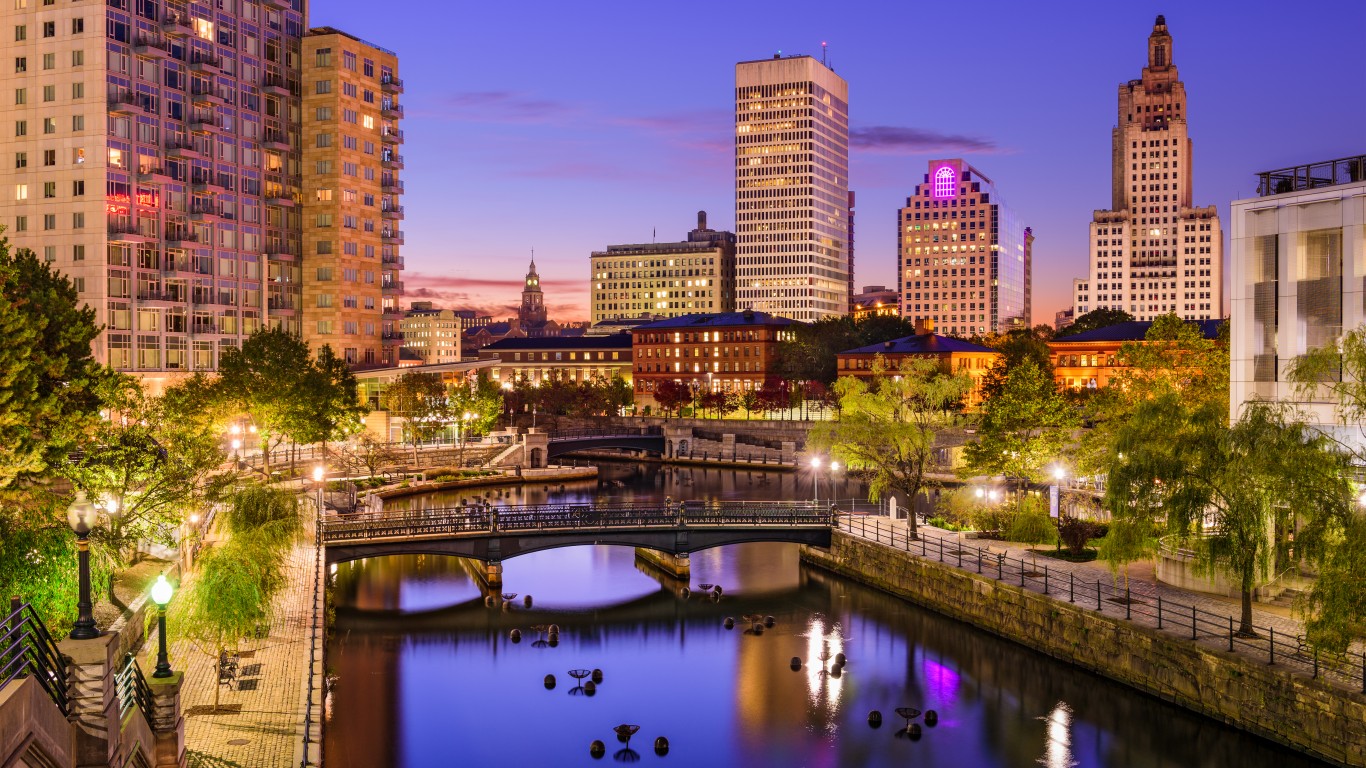
14. Rhode Island (tied)
> Adults with at least a bachelor’s degree: 34.8% (2019); 34.4% (2018)
> Median earnings for bachelor’s degree holders:/strong> $57,398 (13th highest)
> Median earnings for all workers: $46,060
> Unemployment: 3.6% (2019); 4.0% (2018)
In Rhode Island, nearly 35% of adults have a bachelor’s degree, tied with Utah for the 14th largest share among states. However, compared to much of the New England region, Rhode Island’s bachelor’s degree attainment rate is relatively low. Maine is the only New England state with a lower educational attainment rate than Rhode Island.
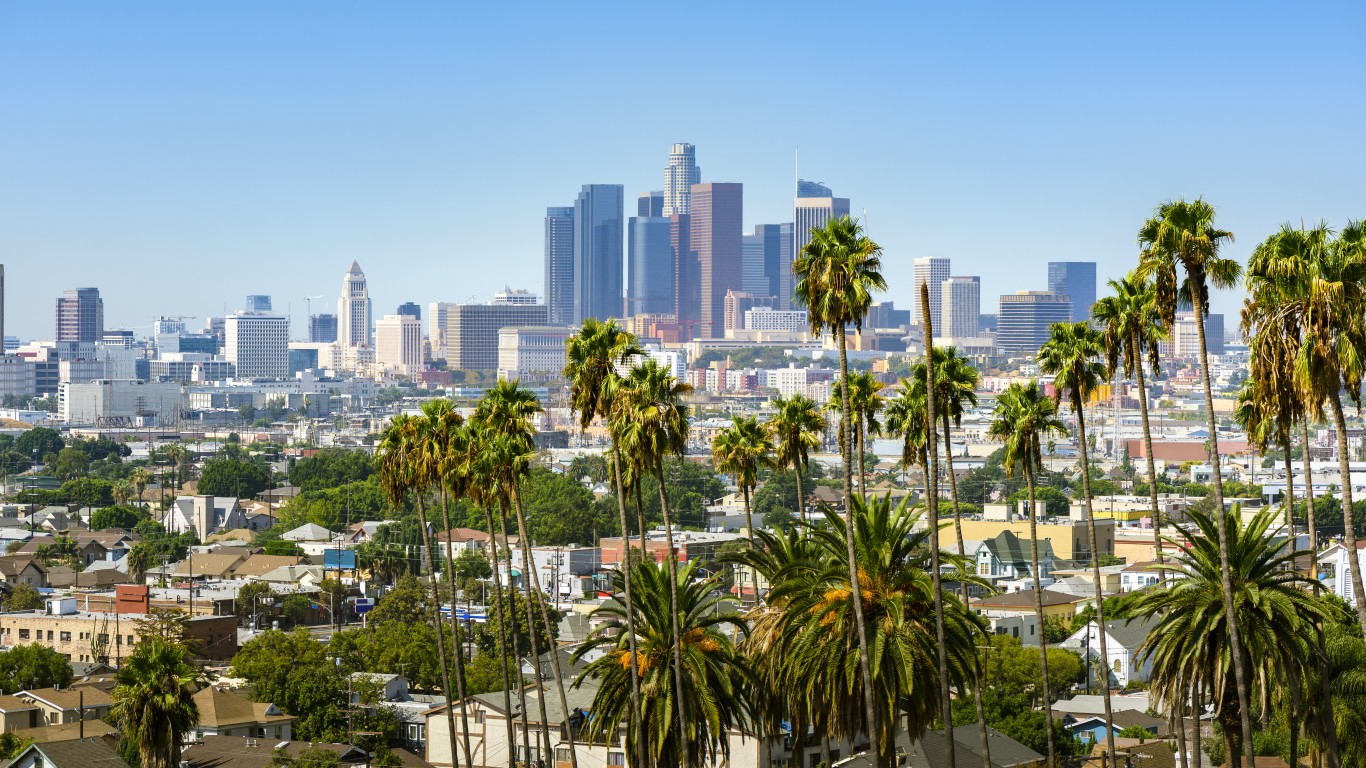
13. California
> Adults with at least a bachelor’s degree: 35.0% (2019); 34.2% (2018)
> Median earnings for bachelor’s degree holders:/strong> $65,078 (4th highest)
> Median earnings for all workers: $45,095
> Unemployment: 4.0% (2019); 4.3% (2018)
California is one of 13 states with a bachelor’s degree attainment rate of 35% or higher, despite the fact that it has the lowest high school diploma attainment rate of any state. Just 84% of Californians 25 and older have finished high school. Meanwhile, 88.6% of all American adults in the same age group have a high school diploma.
Though workers with a college education tend to earn higher incomes than those without in every state, the difference is especially stark in California. Median earnings for all workers ranks 13th among states, at just over $45,000. Meanwhile, the typical worker with a bachelor’s degree in the state earns nearly $20,000 more per year, at $65,000. Only three states have a higher median income among workers with a bachelor’s degree.

12. Illinois
> Adults with at least a bachelor’s degree: 35.8% (2019); 35.1% (2018)
> Median earnings for bachelor’s degree holders:/strong> $60,357 (10th highest)
> Median earnings for all workers: $45,015
> Unemployment: 4.0% (2019); 4.3% (2018)
With a bachelor’s degree attainment rate of 35.8%, Illinois ranks as the 12th most educated state. Job security tends to go up with educational attainment, and the state also had the 12th highest annual unemployment rate in 2019, at 4.0%. Though Illinois has one of the highest bachelor’s degree attainment rates among states, its high school diploma attainment rate is lower than that of most states, at just under 90%.
[in-text-ad-2]

11. Washington
> Adults with at least a bachelor’s degree: 37.0% (2019); 36.7% (2018)
> Median earnings for bachelor’s degree holders:/strong> $62,447 (7th highest)
> Median earnings for all workers: $48,567
> Unemployment: 4.3% (2019); 4.5% (2018)
Washington ranks as the second best educated state in the West — trailing only Colorado — and the eleventh best educated nationwide. Of all adults 25 and older in the state, 37.0% have a bachelor’s degree or higher compared with 33.1% of adults nationwide.
Incomes tend to be higher in better educated states, and Washington is no exception. The typical household in the state earns $78,687 annually — about $13,000 more than the national median household income.

10. Minnesota
> Adults with at least a bachelor’s degree: 37.3% (2019); 36.7% (2018)
> Median earnings for bachelor’s degree holders:/strong> $60,316 (11th highest)
> Median earnings for all workers: $47,050
> Unemployment: 3.2% (2019); 2.9% (2018)
Minnesota ranks among the 10 most educated states, with a bachelor’s degree attainment rate of 37.3%. It also ranks third in high school diploma attainment, at 93.6% — 5 percentage points higher than the U.S. high school attainment rate. Unlike the majority of the most educated states, Minnesota’s unemployment rate increased slightly from 2018 to 2019. However, the state’s 3.2% unemployment rate in 2019 was still below the national unemployment rate of 3.7%.
[in-text-ad]
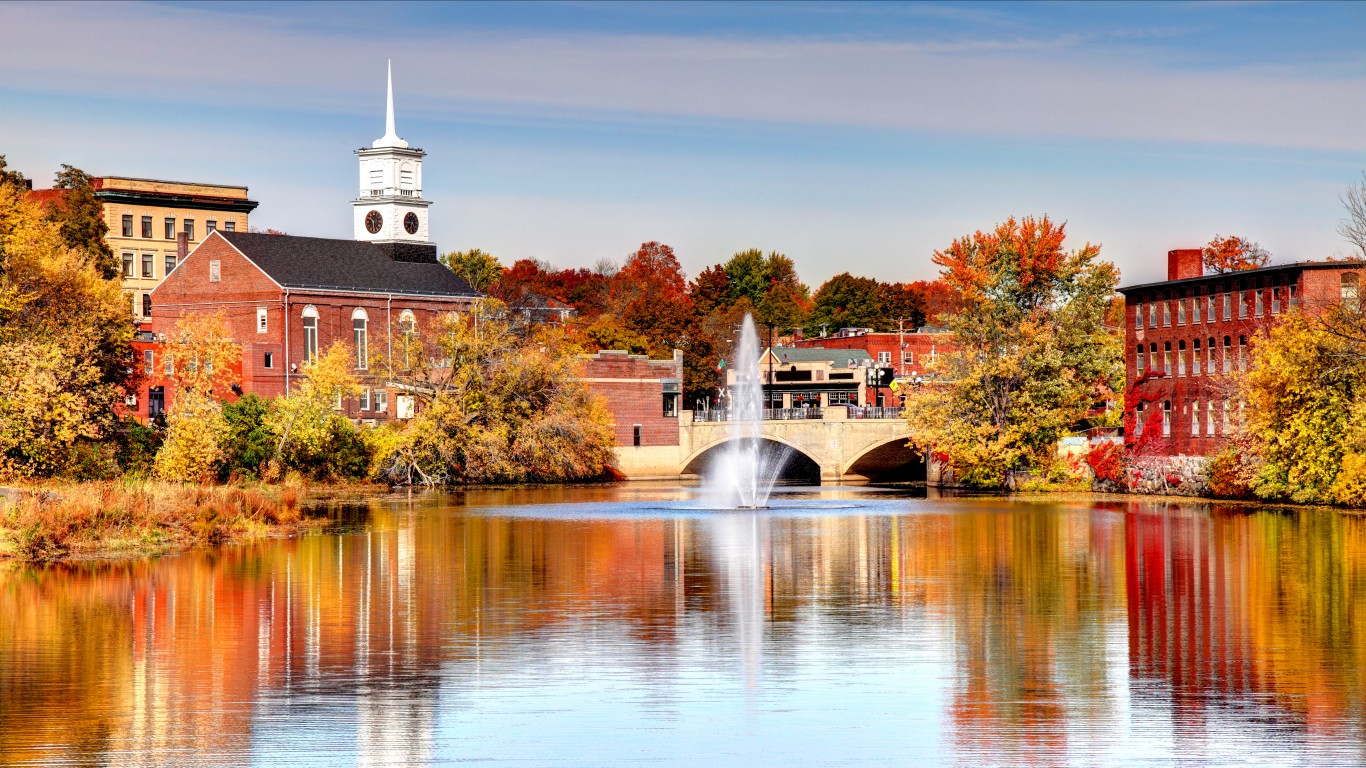
9. New Hampshire
> Adults with at least a bachelor’s degree: 37.6% (2019); 36.8% (2018)
> Median earnings for bachelor’s degree holders:/strong> $60,544 (9th highest)
> Median earnings for all workers: $47,392
> Unemployment: 2.5% (2019); 2.6% (2018)
New Hampshire’s bachelor’s degree attainment rate of 37.6% is higher than in all but eight other states nationwide. Adults in the state are also more likely than most to have an advanced degree. Among all residents 25 and older, 14.7% have a graduate or professional degree, compared with 12.8% of all Americans in the same age group.
As is often the case in well-educated states, incomes are generally higher than average in New Hampshire. The typical New Hampshire household earns $77,933 a year, over $12,000 more than the national median income of $65,712.

8. New York
> Adults with at least a bachelor’s degree: 37.8% (2019); 37.2% (2018)
> Median earnings for bachelor’s degree holders:/strong> $62,699 (6th highest)
> Median earnings for all workers: $47,645
> Unemployment: 4.0% (2019); 4.1% (2018)
New York is home to the eighth highest bachelor’s degree attainment rate of all states, with 37.8% of adults holding at least a four-year degree. More so than Americans in most states, New Yorkers have a strong financial incentive to invest in a four-year education. The typical college graduate working in the state earns $62,699, well above the median earnings among all workers with a bachelor’s degree nationwide of $56,344.

7. Vermont
> Adults with at least a bachelor’s degree: 38.7% (2019); 38.7% (2018)
> Median earnings for bachelor’s degree holders:/strong> $47,170 (7th lowest)
> Median earnings for all workers: $41,496
> Unemployment: 2.4% (2019); 2.5% (2018)
In Vermont, 93.1% of adults have a high school diploma and 38.7% have a bachelor’s degree — the eighth and seventh largest shares among states, respectively.
The state ranks among the best educated in the nation despite an apparent lack of well-paying jobs that require a bachelor’s degree. The typical worker with a bachelor’s degree in Vermont earns $47,170 a year, only about $6,000 more than the median earnings for workers of all education levels in the state. Meanwhile, nationwide, the typical worker with a bachelor’s degree earns $56,344, about $15,000 more than the median earnings for all workers.
[in-text-ad-2]

6. Virginia
> Adults with at least a bachelor’s degree: 39.6% (2019); 39.3% (2018)
> Median earnings for bachelor’s degree holders:/strong> $61,529 (8th highest)
> Median earnings for all workers: $46,873
> Unemployment: 2.8% (2019); 3.0% (2018)
Virginia is the sixth best educated state in the country and the second best educated in the South, trailing only Maryland. Nearly 40% of Virginia’s 25 and older residents have a bachelor’s degree compared with just 33.1% of Americans in the same age group nationwide.
Virginia appears to have many well-paying jobs that require a bachelor’s degree. The median earnings for college-educated workers is $61,529, well above the comparable median annual earnings of $56,344 across the U.S. as a whole.

5. Connecticut
> Adults with at least a bachelor’s degree: 39.8% (2019); 39.6% (2018)
> Median earnings for bachelor’s degree holders:/strong> $64,143 (5th highest)
> Median earnings for all workers: $50,788
> Unemployment: 3.7% (2019); 4.1% (2018)
Only four states are home to a larger share of adults with a bachelor’s degree than Connecticut. States with larger college-educated populations tend to have higher incomes overall, and Connecticut is no exception. The typical household in the state earns $78,833 per year, about $13,000 more than what the typical American household earns annually.
[in-text-ad]

4. Maryland
> Adults with at least a bachelor’s degree: 40.9% (2019); 40.8% (2018)
> Median earnings for bachelor’s degree holders:/strong> $65,193 (3rd highest)
> Median earnings for all workers: $52,011
> Unemployment: 3.6% (2019); 3.9% (2018)
Maryland is one of only four states where more than 40% of 25 and older residents have a bachelor’s degree. The state’s 40.9% bachelor’s degree attainment rate is the highest in the South and fourth highest in the country.
Maryland appears to have many well-paying jobs that require a postsecondary education. The median salary for college-educated workers in the state is $65,193, well above the comparable median earnings of $56,344 across the U.S. as a whole.

3. New Jersey
> Adults with at least a bachelor’s degree: 41.2% (2019); 40.8% (2018)
> Median earnings for bachelor’s degree holders:/strong> $67,038 (the highest)
> Median earnings for all workers: $51,786
> Unemployment: 3.6% (2019); 4.1% (2018)
New Jersey is the third most educated state in the country, with 41.2% of 25 and older residents holding at least a bachelor’s degree. Most of the state’s college-educated residents earn over $67,000 per year — the highest median earnings for adults with a bachelor’s degree of any state, and over $10,000 higher than the comparable U.S. median.
New Jersey also ranks among the 10 states with the highest advanced degree attainment rate, with 16.1% of adults in New Jersey holding either a master’s, professional, or doctorate degree. Nationwide, 12.8% of Americans 25 and older have an advanced degree.
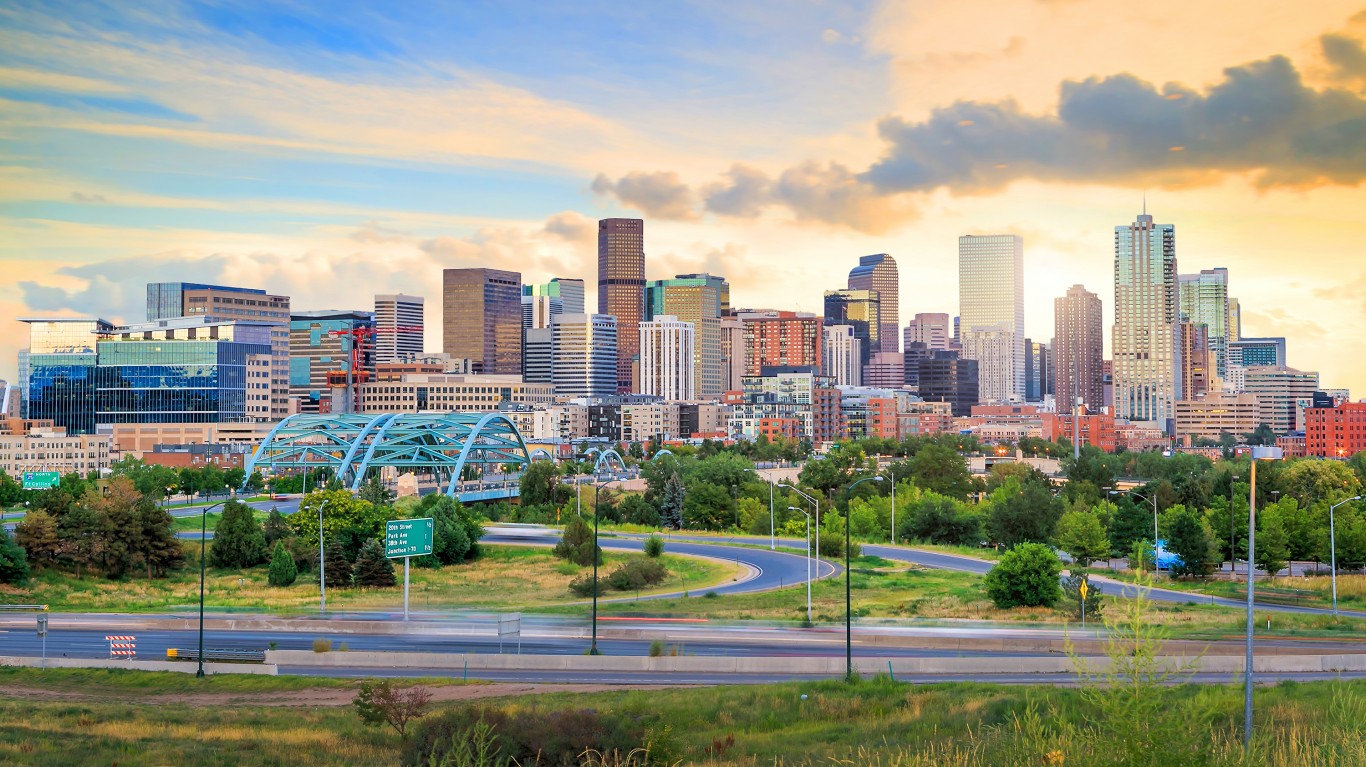
2. Colorado
> Adults with at least a bachelor’s degree: 42.7% (2019); 41.7% (2018)
> Median earnings for bachelor’s degree holders:/strong> $58,229 (12th highest)
> Median earnings for all workers: $46,887
> Unemployment: 2.8% (2019); 3.2% (2018)
In Colorado, 42.7% of residents 25 and older have a bachelor’s degree, the second largest share of any state and by far the largest share in the region. For context, Washington ranks as the second best educated state in the Western U.S. with a bachelor’s degree attainment rate of 37.0%.
The job market for college-educated workers in Colorado likely encourages many to pursue a postsecondary education. The typical worker with a bachelor’s degree in the state earns $58,229 per year, about $2,000 more than the median annual income for workers with a college degree nationwide.
[in-text-ad-2]

1. Massachusetts
> Adults with at least a bachelor’s degree: 45.0% (2019); 44.5% (2018)
> Median earnings for bachelor’s degree holders:/strong> $65,373 (2nd highest)
> Median earnings for all workers: $52,470
> Unemployment: 2.9% (2019); 3.4% (2018)
Massachusetts ranks as the best educated state in the country. Of all state residents 25 and older, 45.0% have a bachelor’s degree — well above the comparable 33.1% bachelor’s degree attainment rate nationwide.
The high educational attainment in Massachusetts is likely due in part to the state’s job market. Well-paying jobs for those with a college education appear common in Massachusetts. The typical working college degree holder in the state earns $65,373 annually, far more than the $56,344 the typical working, college-educated American worker earns per year.
Credit Card Companies Are Doing Something Nuts
Credit card companies are at war. The biggest issuers are handing out free rewards and benefits to win the best customers.
It’s possible to find cards paying unlimited 1.5%, 2%, and even more today. That’s free money for qualified borrowers, and the type of thing that would be crazy to pass up. Those rewards can add up to thousands of dollars every year in free money, and include other benefits as well.
We’ve assembled some of the best credit cards for users today. Don’t miss these offers because they won’t be this good forever.
Flywheel Publishing has partnered with CardRatings for our coverage of credit card products. Flywheel Publishing and CardRatings may receive a commission from card issuers.
Thank you for reading! Have some feedback for us?
Contact the 24/7 Wall St. editorial team.
 24/7 Wall St.
24/7 Wall St.
 24/7 Wall St.
24/7 Wall St.
